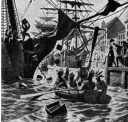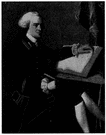Part 2: The Rest of the Story A member of the Boston Assembly, he also joined the Stamp Act Congress, a group of angry Americans who got together to discuss how to fight back against what they saw as "taxation without representation." The British government eventually repealed the Stamp Act, but they soon replaced it with even harsher measures and talk of revolution began to spread.
His most famous moment came when he signed the Declaration of Independence, in 1776. Hancock's name was on a list put out by the British government that offered a reward for the capture of several leaders of the revolution. Hancock, as the president of the Continental Congress, was first to sign the Declaration. He wanted to make an impression and to thumb his nose at the Hancock suffered from gout, a disease of the joints, and retired from public life not long after. He was still active in his state, however, and helped write its constitution. He managed a recovery from his physical ailments and was elected governor of Massachusetts, a total of nine times. In fact, he was governor when he died, in 1793. Oddly enough, he was one of a few men who served as president of the United States under the Articles of Confederation, the now-defunct government blueprint that was replaced by the Constitution. Hancock campaigned on behalf of the new form of government and helped convince the people of his state to ratify it, which they did in 1788. He also was instrumental in the creation of the American Navy. First page > Early Years > Page 1, 2 |
|
Social Studies for Kids
copyright 2002–2024
David White

 One of Hancock's own ships, the Liberty, was seized by British authorities, who thought it might contain smuggled goods. Hancock was so outraged that he stood by while a group of angry citizens fought back against the officers responsible for the boat's seizure. (Ironically, Hancock was indeed involved in smuggling, of glass, lead, paper, and tea.) Not too long after, in response to the new
One of Hancock's own ships, the Liberty, was seized by British authorities, who thought it might contain smuggled goods. Hancock was so outraged that he stood by while a group of angry citizens fought back against the officers responsible for the boat's seizure. (Ironically, Hancock was indeed involved in smuggling, of glass, lead, paper, and tea.) Not too long after, in response to the new  In 1774, he made a public speech reminding Americans of the deaths caused by British troops in the
In 1774, he made a public speech reminding Americans of the deaths caused by British troops in the  British. After he signed, he had this to say: "The British ministry can read that name without spectacles; let them double their reward."
British. After he signed, he had this to say: "The British ministry can read that name without spectacles; let them double their reward."
